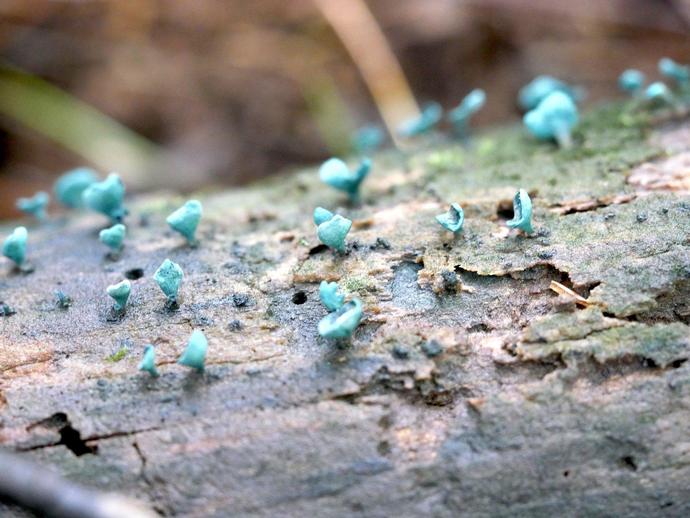September 29, 2020
I'm continuing my top five favorite finds from Saturday's Virginia BioBlitz 2020 with my #4 pick: the Chlorociboria fungus!
While it may look like a satellite image of an alien planet, this is a photo of tiny fruiting bodies from a fungus belonging to the genus Chlorociboria. There are two common species of this fungus found in temperate areas -- Chlorociboria aeruginascens and Chlorociboria aeruginosa -- but the only way to tell the difference between the two is by examining the spores under a microscope, so we'll just say it's one of them and leave it at that!
What struck me about this fungus, of course, is its striking blue color. The fruiting bodies produce a pigment called Xylindein, and not only does it cause the fungus to look blue, it also stains the wood that it grows from a greenish-blue color. This wood is highly prized by woodworkers and is often used in the creation of "Tunbridge ware," which is a form of decoratively inlaid woodwork.
Like me, you might look at this fungus and find yourself wondering why there are so few blue things in nature. Why is blue such an uncommon color? One reason is that many animals get their pigments from the food they eat. Since a blue pigment isn't very good for photosynthesis, only a tiny number of plants produce a blue pigment, so blue pigments very rarely make their way up the food chain.
Interestingly enough, a lot of the blue animals we DO see aren't truly blue. For example, while there are a whole bunch of butterflies that appear blue, there are only a handful of species that actually produce blue pigment, such as the obrina olivewing (Nessaea obrinus). The rest get their blue color through a process known as "coherent scattering" in which the scales on their wings scatter light waves and the interference of the waves creates a blue color. By actually producing a blue pigment, the Chlorociboria fungus is in pretty rare company in nature!
ABOUT #BENINNATURE
Social distancing can be difficult, but it presents a great opportunity to become reacquainted with nature. In this series of posts, Administrator of Science Ben Williams ventures outdoors to record a snapshot of the unique sights that can be found in the natural world. New updates are posted Monday - Friday, with previous posts highlighted on the weekends.
NATURE PHOTO IDENTIFICATIONS
If you discover something in nature that you would like help identifying, be sure to message us right here on Facebook with a picture (please include location and date of picture) and we'll have our experts help you identify it!

 Hours & Admissions
Hours & Admissions Directions
Directions

